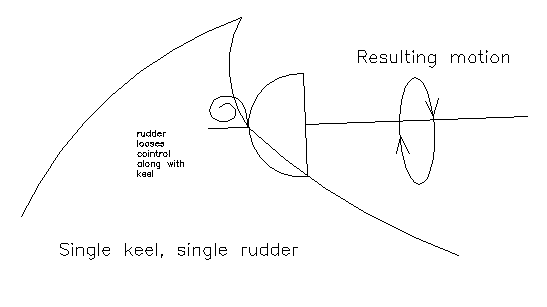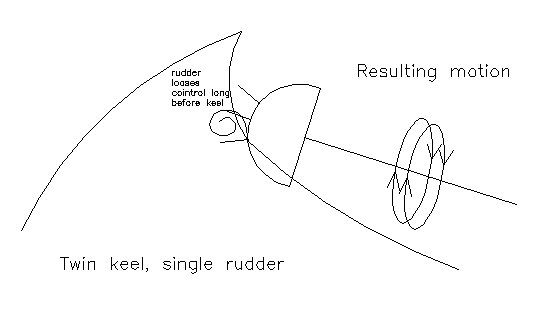“Tripping over the keel” is a common term in offshore sailing. It refers to the problem of broach and/or capsize resulting from the inability of a boat to get its keel clear of the water before a loss of steering or capsize occurs. The twin keel article points to one cause of this problem.
In an effort to solve the problem of wetted surface, fin keels were introduced. However, this introduced the problem of broaching and capsize. Separating the rudder from the keel leaves open the possibility that as the keel lifts to avoid a breaking sea, the rudder will come clear of the water, allowing the hull to pivot around the keel, resulting in a broach, or broach induced capsize.
Some designers have used lifting keels to solve this problem (French boats especially). In extreme conditions the keel is lifted, allowing the boat to run-off using the rudder alone. However, the added complexity of a moving keel has led to failures. As well, lifting the keel moves the center of gravity higher, which is not something you typically desire in extreme conditions.

As the boat heels in breaking seas, and the keel comes clear of the water, typically with a single rudder, the rudder also comes clear. Because the rudder is usually shorter than the keel, it often comes clear before the keel. This can cause the boat to pivot around the keel, leading to broach and capsize.
Another approach is to use twin rudders. Twin rudders have been found to solve/minimize the problem of broaching and broach induced capsize. The reason for this is as follows:

With twin rudders the leeward rudder is not clear of the water when the keel is clear. This allows steering to be maintained, avoiding the tendency to broach and capsize.
What about twin keels and a single rudder?

This is worse. As the hull heels to clear the leeward keel, the rudder comes clear of water long before the leeward keel. A broach is almost unavoidable.
Twin keels and twin rudders? If the twin keels and twin rudders are in-line, then the boat behaves similarly to a single keel, single rudder configuration. If the rudders are outboard of the keels, then the boat will behave more like a twin rudder, single keel configuration. If the rudders are inboard of the keels, then the boat will behave more like a twin keel, single rudder configuration. See twin keels.